What is the history of Byzantine Empire? Information about the government, culture, political developments, maps and evaluation of Byzantine Empire.
BYZANTINE EMPIRE, is an expression in use since the Renaissance to identify the Roman Empire after the transfer of imperial administration by Emperor Constantino I (Constantine the Great) from Rome to Constantinople in 334 a. d. The term “Byzantine” is, in fact, a misnomer. The new capital certainly rose on the site of a much earlier Hellenic colony on the European side of the Bosporus, and this colony had been called Byzantium. Moreover, some archaizing Roman Empire writers of the Middle Ages did occasionally use this name for their city. But the successors of Constantine I, right down to the fall of Constantinople in 1453 a. d., never thought of or referred to themselves as “Byzantines.” They considered themselves “Romans,” the sole heirs to and representatives of the imperial tradition of Augustus Caesar. This tradition implied the stupendous pretension that the empire was divinely ordained and one day would reassert its dominion over all the territories once ruled by Trajan (reigned 98-117 a. d.) or by Constantine the Great himself (reigned 324— 337 a. d. ). It is now too late to discard the term “Byzantine.” But it must never be forgotten that it is a modern, and inaccurate, term for the inhabitants of the Roman Empire as it survived during 11 centuries (334-1453) in the eastern Mediterranean, governed from Constantinople.
During these centuries, as was natural, vast changes occurred in the body of the empire, changes that were territorial, administrative, demographic, mercantile, and military in nature. What never changed was the Christian-imperial idea; and as this was the doctrine, faith, and hope to which every “Byzantine” unquestioning-ly adhered, and for which he lived and died, it is important to be clear about its axioms.
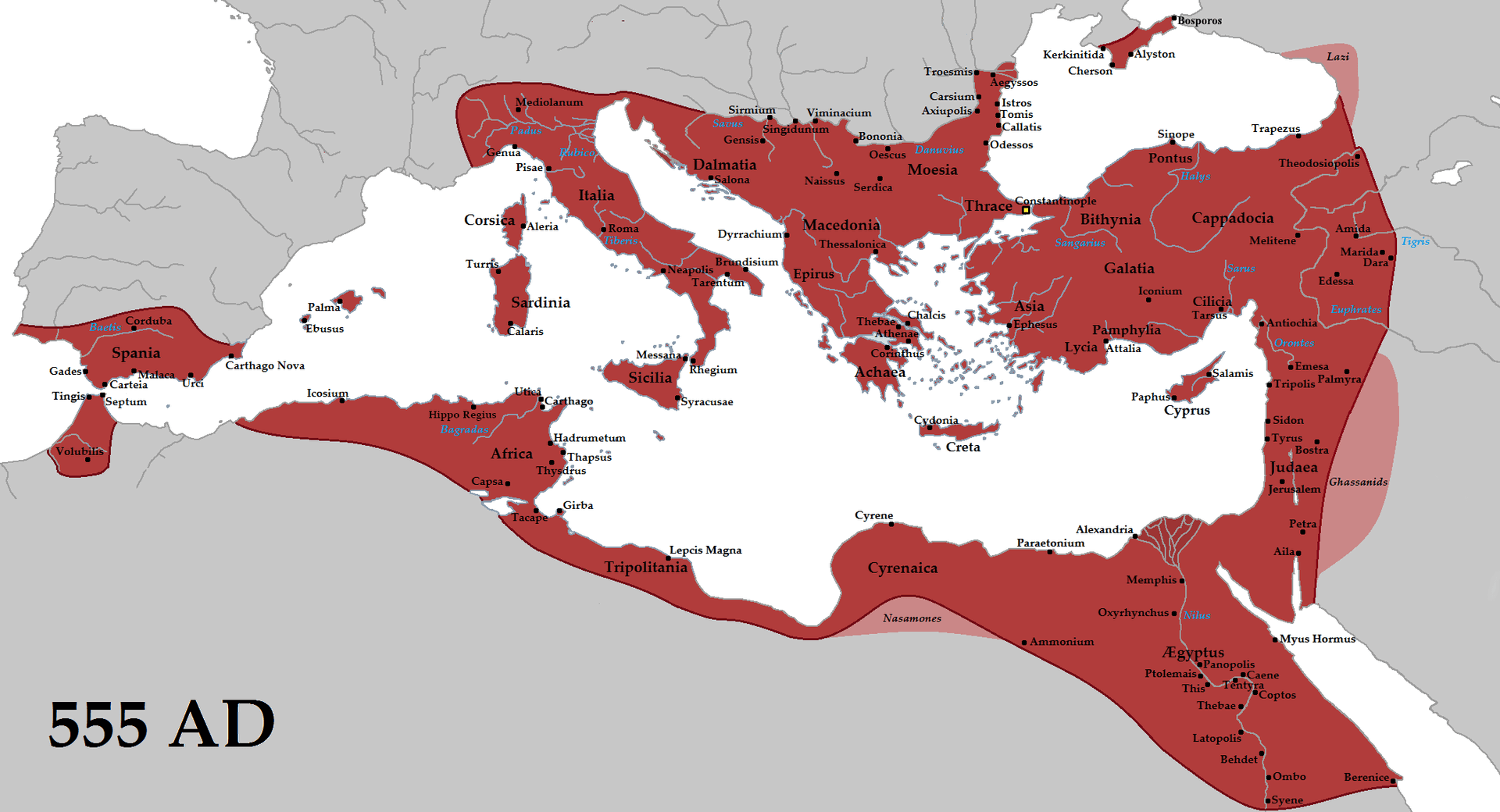
The Empire at its greatest extent under Justinian I, in 555 AD. (Source : wikipedia.org)
The Christian-Imperial Idea.
Every Roman, at least from the time of Augustus, believed in the divine right of Rome to be the single empire of the world, with a duty to preserve universal peace. This right and duty were deduced from the practical successes of Rome’s splendid armies and from the theoretical sanction of its chief god, Jupiter. But the appeal of orthodox paganism was feeble, and in the 3d century a. d. The empire, threatened by barbarian assault and internal economic collapse, seemed in danger of complete disruption for lack of a faith to hold it together. It was the genius or good fortune of Constantine the Great, the founder of Constantinople, that harnessed to the old imperial idea the new and powerful dynamic of Christianity, though, of course, some modifications in the creed of humility and love had to be made to fit it for its new purpose.
The Christian-Roman imperial idea ultimately crystallized as follows. Augustus Caesar and Jesus were contemporaries. That was no accident. The one unified and brought peace to the empire. The other Prince of Peace was sent into this world to interpret the celestial order to the material creation. This celestial order was regarded as a single empire, with a monarch, a governing hierarchy, and an angelic army organized in legions. According to this theory, Jesus said that His Father willed that this temporal world should be similarly organized, that is, it should be a unity under the rule of Rome alone. Hence, successive Roman emperors were considered to be elected by Almighty God Himself, chosen by Him to carry out His will for the government and pacification of the created world.
The emperor was, under God, all-powerful. Thus, he was regarded as the supreme governor, the supreme proprietor, the commander in chief, the source of law, the origin of all offices, and the fount of all honors. His duties were to interpret the divine will, to impose and protect orthodox Christian belief, to govern his subjects with mercy and justice, and to advance that moment when all the inhabited world should kneel in homage and offer their riches to the earthly vicegerent of Christ. Emperors so privileged were, in theory, unassailable by malice or treason. In practice, they were very frequently deposed or assassinated. But this did not invalidate the purposes of God; it merely meant that God had withdrawn His favor from an unworthy ruler and conferred it on a new elect. Therefore a successful usurper was the appointed of God, as his predecessor had been before him.
The tenet that Byzantium should one day rule again over the Mediterranean and European possessions of Augustus and Constantine the Great (the oikoumene, or “inhabited world”) appeared, especially in and after the 7th century, to be hopelessly chimerical. The empire, except during two centuries of expansion between approximately 850 and 1050, grew ever smaller and weaker. But this did not weaken the prime postulate of the empire. If the promised consummation seemed to recede rather than to approach until, in the 14th and 15th centuries, it reached the vanishing point, it was believed that this was due to no change in God’s purpose, but to the “sins” of His people. These sins were partly moral, but also, and more important, doctrinal. Thus, the catastrophic decline in Byzantine power between the death of Emperor Michael VIII Palaeologus in 1282 and the Ottoman conquest of Constantinople in 1453 was, in the eyes of church and people, due not to social, economic, or military causes, but to repeated compromises on the part of the Palaeologan sovereigns with Catholic “heresies.” The consequent alienation of God (despite His “long-suffering”) from His chosen people was inevitable and inexorable.
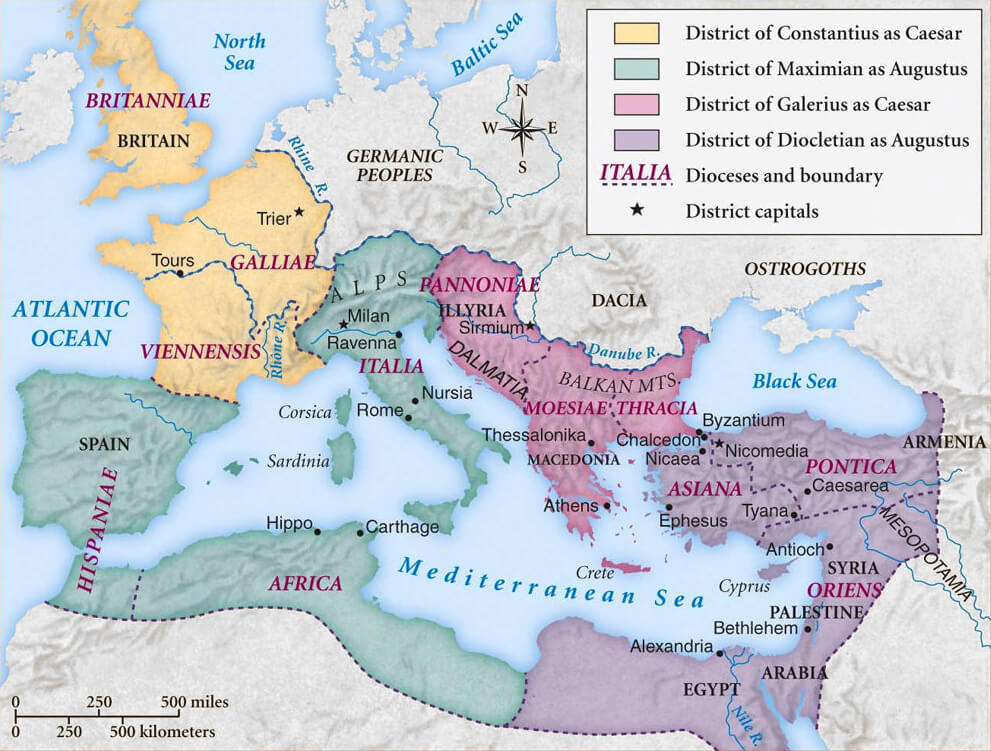
Map of the Roman Empire showing the four Tetrarchs’ zones of influence after Diocletian’s reforms. (Source : wikipedia.org)
It is important to note that among the several strands that combined to weave this imperial theory, the Jewish Old Testament, as interpreted by the early Christian Fathers, was by far the strongest. It was from the denunciations of Leviticus and Deuteronomy, and from the messianic utterances of the prophet Isaiah, that the Christian Romans derived their ideas of themselves as the chosen race, of their city as the “new Jerusalem,” of their sovereignty as natural and God-given, and, above all, of sin as the direct cause of every setback or disaster. This theory implied a very curious egocentricity. For the Byzantines, foreigners or outsiders had no independent significance or even existence except insofar as they contributed to fulfilling or hindering God’s purposes for His earthly empire. They were merely His rods for chastening those whom He loved.
Government and Culture.
Two other elements of prime importance that remained constant during all the long life of the empire were the method of government and the cultural background. The method of government was bureaucratic. The later emperors inherited from the earlier the system of administration by a bureaucracy of laymen. Medieval Europe had no comparable system. Indeed, in the empire itself, from the 11th century, the long and eventually successful revolt of landed proprietors against government by civil servants was a chief cause of the state’s decay and ultimately of its extinction. The departments of the central treasury, of the vast imperial estates, of the war office, and of foreign affairs ( which included imperial communications and the secret service) all changed their titles and modified their respective functions from time to time. But in all ages that’ were manned by a hierarchy of highly educated clerks. These bureaucrats were the most characteristic product of Byzantine civilization. They owed their promotion to their own abilities, were intensely proud of their tradition, and did more than any other class to preserve the Byzantines’ conviction of their innate superiority over all other portions of mankind.
Much of their arrogance and self-righteousness was derived from their “Greek” education. The official language of the empire from the 7th century was Greek, and even before then, Greek had been far more commonly spoken than Latin in Asia Minor, the heart of the eastern empire. The backbone of this ( Hellenistic ) Greek cultural tradition was the study of late Greek rhetoric, which taught its students to be quick and, as they believed, graceful and eloquent of speech. They scarcely understood the cultural heritage of ancient Hellas, as it has been recovered in Western Europe since the Renaissance, and lyric poetry and ancient art were closed books to them. But their pride in their “Hellenic” letters led to the preservation of Greek classical literature, insofar as it has been preserved. And the fact that the New Testament and patristic literature used, in the main, the same language reinforced the Byzantines’ belief in their exclusive possession of all that was of value in literary and religious writings.
Orthodoxy.
Last, but by far the most important, of the common elements was Christianity. Every Byzantine passionately believed in his “orthodox” version of this creed. Not only did it give him an imperial faith in his own destiny and importance; it also gave him a genuine and inspiring love of the basic Christian qualities-charity, humility before God, a desire to seek after knowledge of Him, and, at the end, to achieve a personal “deification.” The true Byzantine, lacking as he was in intellectual genius or originality, pursued, in no merely formal fashion, the virtues of peace, kindliness, purity, and brotherly love. The conduct of the higher clergy, in a church which, politically speaking, had been established by Constantine I as yet one more department of the state, might seem to believe this statement, marred as this conduct all too often was by envy, rancor, and personal ambition. Its lower orders, comprising the secular priests, the monastic communities, and the ranks of popular saints, present a different picture, one which is populated from age to age by good men who despised worldly things and trod, according to their lights, in the steps of their Master. Christianity was the vital influence, and therewith the saving virtue, of Byzantium.
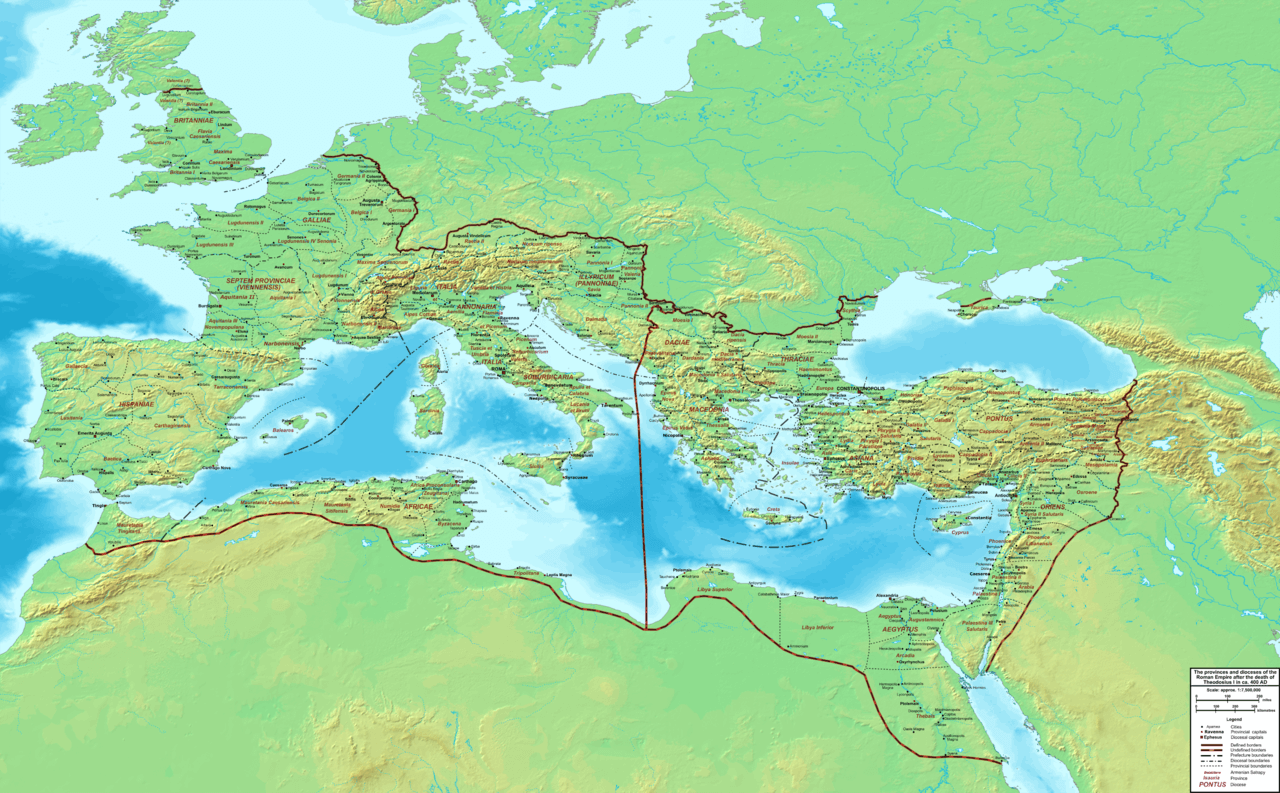
The dioceses and provinces of the Roman Empire in 395, before the final partition into Eastern and Western empires. (Source : wikipedia.org)
Thus, in sum, the Byzantine Empire may be depicted throughout its existence as the legitimate heir of the old, bureaucratically governed Boman Empire, but with these modifications. First, its ultimate triumph was thought to be guaranteed by a Christian and messianic, instead of a pagan and fatalistic, sanction. Second, its official, but never its universal, language was no longer Roman Latin but Roman Greek. Third, its culture consequently rested on some of the classical Greek authors and on handbooks of the Hellenistic era.
Political Developments—Early Period.
Byzantine political developments must next be summarized briefly in order to see how the state confronted its disasters or used its triumphs. In the 4th to 6th century—from about 370 to 570—the chief perils of the Mediterranean empire came from Germanic invaders. Britain and Spain, and for a time Gaul, Italy, and Africa, were wholly lost to the Saxons, the Goths, the Franks, and the Vandals. But these tribes inevitably quarreled with one another; and the empire, with half a millennium of diplomatic experience to draw upon, was able to give decisive support to the Franks of Gaul and the Ostrogoths of Italy against their rivals, the Visigoths and Vandals, so that the former peoples preserved at least a show of dependence on the Romans and were content to take their titles, if not their policies, from Constantinople.
In the eastern Mediterranean the Roman forces were stronger, and in the 5th century they defeated at least two Gothic attempts to take over the empire. At length, in the 6th century, Emperor Justinian I felt himself strong enough to take the offensive in the West and was able to establish a practical, instead of a theoretical, control over Spain, Africa, Italy, and Dalmatia. At enormous cost in men and money his objectives were in the main achieved. But his reconquest was ephemeral. New and powerful invaders were still massing behind the frontiers. Justinian was, in Renaissance parlance, “the last of the Romans”; for after him came the deluge.
The Empire Threatened.
The second distinct period of Byzantine history, from the early 7th to the early 11th century, is the story of an empire no longer Mediterranean, but reduced (by 750) to governing only Asia Minor, Thrace, some islands, and the foot of Italy. During the first part of this period, reconquered Italy was mostly lost to the Germanic Lombards; the Greek peninsula to the Slavs; and Syria, Palestine, Egypt, and North Africa to the Arabs, who, converted to Islam (the “Surrender to God”), erupted in 632 from the Arabian Peninsula.
Of these menaces, the last was by far the most formidable, since it threatened the very life and heart of the empire itself. Twice, in 674 and 717, massive Muslim attacks were made on Constantinople itself. They were repelled only by the strength of the Theodosian walls and by the energy and resolution of emperors Con-stantine IV (reigned 668-685) and Leo III (reigned 717-741). Moreover, from 680 the power of the Bulgarians was permanently established between the Danube River and the Balkan Mountains and for centuries constituted a threat nearly as serious as that of the Muslims. It is astonishing that the empire not only failed to succumb to, but actually surmounted, these traumatic experiences with undimmed faith and vigor and at length, in the Age of Conquest (about 863 to 1025), succeeded in recovering a substantial part of what had been lost.
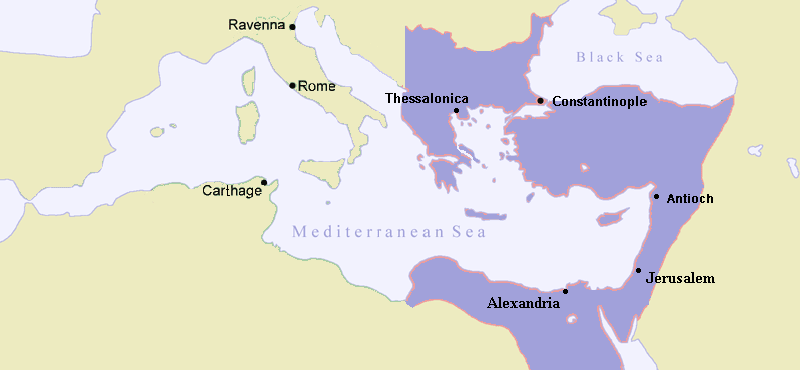
Eastern Roman Empire, c. AD 480 (Source : wikipedia.org)
Imperial Reorganization.
Two expedients were adopted to meet the crises. The first of these was the wholesale importation into Asia Minor of Slavs, who restored agriculture on a new system of land tenure, and of Armenians, who by their genius for war and administration rehabilitated the army and government. Second, the Christian-imperial idea was intensified, inspiring the Byzantines, as the upholders of the tradition of ecumenical Rome, with a more mystical notion of Christ’s purpose—His empire’s ultimate recovery. A discussion of both these phenomena is of the utmost importance in gaining an understanding of the achievements of the period.
The immigrants were settled in villages, or “communes,” where they lived as small farmers with free rights of sale or alienation of their properties. In return, they paid taxes to the central treasury at regularly revised rates. This ensured and encouraged cultivation of the soil and a steady revenue to the state. Moreover, the better estates, possessed chiefly by Armenian settlers, also supplied the empire with its splendid native cavalry; for the head of such an estate was a full-time soldier, whose needs were met by the industry of his family and household. This native and comparatively free militia was the backbone of imperial defense and the spearhead of imperial conquest until the 11th century. It relieved the central treasury of the need to rely heavily on brigades of foreign mercenaries.
Above all, the whole empire was placed administratively on a war footing. The territories of Asia Minor, and later of the Balkan Peninsula, were divided into provinces, or “themes,” subject to martial law (“theme,” or thema, is derived from a cognate word that designated a military register), and under the absolute control of a military governor appointed by the crown. The theme in turn was subdivided into two or three subprovinces, under lieutenant generals. The sub-provinces in turn were divided into garrison towns, or forts, where the local militia were subject to an intense and continual military training.
Such was the new population, the new order, and the “new model” of Byzantine rural and military organization. Modern opinions differ as to the date and authorship of these reforms. But the Byzantines themselves attributed them, probably correctly, to the house of Heraclius (approximately 610-711 ).
All this was achieved without any compromise of the “Imperial Faith.” The immigrants were systematically Byzantinized by the Christian church and the government machine. Instead of the old tradition of the Fortune of Rome, still strong in the early period of Constantine I and Justinian I, Christ and His divine mother and His saints were believed to be in sole charge of imperial policies and direction. And Christ was understood to make these known through mystical communication to His elect, the Roman emperor.
Some centuries (about 250 years in all) passed before the fusion was complete. Political objectives were, during this period, often frustrated by savage religious disputes, of which the Iconoclast controversy (726-787 and 815-843) was the most disruptive. But at last, in the middle of the 9th century, the whole machine began to operate efficiently. The Muslims were decisively checked in 863. Four years later (867) the gifted Armenian dynasty of the so-called Macedonian, or “Basilid,” house was founded by Basil I, and it ruled until 1056.
The Age of Conquest.
During this 189 years, the Age of Conquest was consummated. Basil I himself converted and Byzantinized the Slavic settlers of Greece and Dalmatia. John Curcuas, the brave general of Romanus I (reigned 920-944), broke through the Muslim border that ran from Trebizond to Tarsus, and reestablished Byzantine influence in Armenia and Georgia. The usurper Nicephorus II Phocas (reigned 963—969) recaptured Crete, Cyprus, Tarsus, Aleppo, and Antioch. His successor John I (reigned 969-976), the most gifted general in Byzantine history, smashed a powerful Russian (Varangian) invasion of Bulgaria, and then, turning eastwards, put nearly all of Phoenicia and Palestine under Roman protection.
John was succeeded by the legitimate emperor, Basil II (reigned 976-1025), the great great-grandson of Basil I. The energy and ability of this outstanding leader brought Byzantine power to its apogee. With unfailing tenacity he put down the successive revolts of the military aristocrats and succeeded in taking over intact the splendid military machine that they had forged and led to victory. With it he conquered the whole of Bulgaria (991-1019) and pushed the eastern frontier far to the east of Lake Van. There can be no doubt that Basil intended to restore the territorial empire of Justinian I, if not that of Augustus, in the West. He maneuvered unsuccessfully to get the papacy under his control. He next tried, by the expedient of a dynastic marriage, to link the then enormous dominions of Byzantium with those, almost equally large, of the Saxon emperors of the West. But he was frustrated by the death of the Western Emperor Otto III. At last he contemplated the conquest of Sicily and Italy. Time was not on his side, and in 1025 he died at the age of 68. With his death the practical possibility of restoring the old Boman Empire vanished forever.
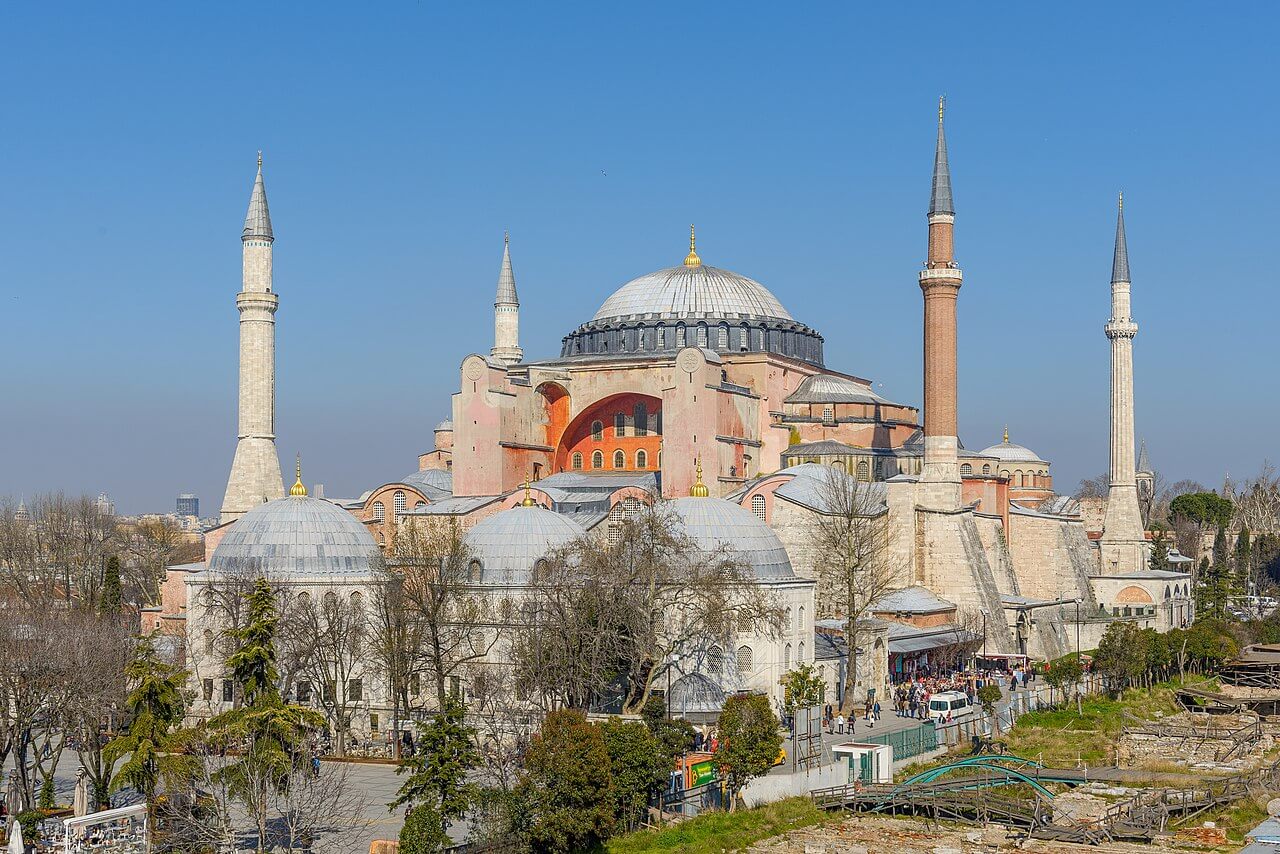
Exterior view of the Hagia Sophia, 2013 (Source : wikipedia.org)
Decline.
The third period in Byzantine history, the period of Byzantium in slow decline, lasted from the 11th to the 15th century—approximately 1025-1453. In this increasingly confused period, certain aspects or trends stand out. First, there was the military decline, due to social conflicts, and the consequent return to dependence on foreign mercenaries, which bankrupted the state. Second, the empire developed a decisively Western orientation once the bulk of Asia Minor had been occupied by the Seljuk Turks (1073 and after). Third, there arose out of the second aspect a native Byzantine reaction against the repeated attempts of the rulers to compromise with Catholic “heresies” in order to prolong, with the aid of Western arms, the life of their state.
The populace of Constantinople and the Byzantine bureaucracy preserved to the last the age-old concept of the pax Romana. They hated war, and in consequence everything to do with soldiering. Hence they were in sharp conflict with the military aristocracy, whose trade was fighting. This aristocracy had arisen in and after the 7th century. It was mainly of Armenian stock, and in course of time it had become a dominant caste of intermarrying clans. High command was their monopoly, and the military system of provincial government played into their hands. These two powerful classes—civil and military—were keen competitors for the acquisition of landed properties and estates.
Basil II was the last emperor who was powerful enough to compose their enmities and control their rapacity. After his death, their disastrous feuds, which took no account of the steadily worsening foreign situation, sapped the strength of the empire. This ruin was accelerated by the success of the bureaucrats in continuing to reserve the imperial crown to their nominees during almost all of the next fateful half century (1025-1071). Military appropriations were cut to the bone, the soldiers encouraged to buy exemptions from service, their hereditary leaders vilified and insulted. Yet it would be unjust to put on the bureaucratic party all the blame for Byzantium’s decline. The military aristocrats were at least as much responsible for it, since their continual encroachments on the estates of the native militia destroyed the very foundation of the state’s war machine. The whole principle of a free soldiery —fighting for, and paying taxes to, the emperor-was crippled when the soldiers’ estates were brought up by the “powerful” (as the nobles were called), and the soldiers themselves became serfs.
The splendid edifice of Basil II crumbled into ruin in an unbelievably short space of time. The year 1071 marked the collapse in West and East. The Norman invaders of Italy occupied Bari, the capital of Byzantine southern Italy. On the field of Manzikert, on August 19, a Roman force, painfully scraped together by Emperor Romanus IV, was annihilated by a much smaller force of Seljuk Turkish cavalry led by Alp Arslan. Owing to the dissolution and neglect of the native, or “thematic,” brigades, this “Roman” army consisted almost entirely of mercenaries, half of them cowards, the other half traitors.
The irretrievable disaster of Manzikert was a direct cause of the crusading movement (1097-1291), in the sense that Byzantium had ceased to be a great power separating the western European and Muslim worlds. This confrontation of the European powers with Byzantium was fatal to the latter. From the beginning, the Frankish and especially the Norman leaders had had at least one eye on the empire, which offered riches, estates, and plunder far more alluring than those of Muslim Syria or Palestine. The conviction that Byzantium had very little strength to defend its enormous riches grew during the 12th century. And with this conviction came the belief that, as a race of cunning and treacherous swindlers, the Romans had “no right” to continue as possessors of their own lands. The hatred between Byzantines and the “heretical” Franks at length surpassed any that Christians had ever felt for pagans or Muslims. In the notorious Fourth Crusade (1204) Frankish fanaticism, skillfully manipulated by Venetian statesmanship, was turned on Constantinople. The city was stormed, Frank was set up as emperor of the Latin Empire of Constantinople, and the Byzantine territories were partitioned among the conquerors. In this fearful sack, accompanied by devastating fires, muoh of the heritage of the ancient as well as of the medieval Byzantine world perished forever.
Following this, an unlikely development took place. The legitimate Byzantine power, instead of becoming extinct, took root in the neighboring city of Nicaea, beyond the Bosporus. Under the brilliant house of Lascaris (1204-1258), the old empire rallied, and evinced a renascent freshness and expansion not seen since the 9th century. It surpassed its only significant Greek rival, the Despotate of Epirus. In half a century, sound economic and military policies and brilliant diplomacy brought this new realm to a commanding position from which it could reclaim the old capital of Constantinople from the remnants of the Western Crusading dynasty (1261).
The recovery of Constantinople by the Greek “Romans” was inevitable, but also, in the long term, probably a disaster. Once more the dead weight of a millennial tradition settled down on the empire; and in recovering the old city, it also disinterred the old illusion of world supremacy. There were no men or money to make good the claim. Michael VIII Palaeologus (reigned 1259-1282), who recaptured the city, was an able man and an adroit diplomatist, the last Roman emperor who had any claim to being a major figure in European history. But he saw, as his far less competent successors also saw, that some kind of religious concordat with Rome was essential if Western support was to be secured against the encroaching Muslims. All efforts at compromise with the Catholics (as in 1274, 1369, and 1439) were denounced by theOrthodox party, which saw clearly that Westerners, if they came at all, would come not as allies but as robbers.
In the 13th to 15th centuries there arose three great contenders for the reversion of the empire. Charles, the Angevin king of Naples and Sicily, headed a coalition against Byzantium until he was forced in 1282 to turn his attention to a rebellion within his own kingdom. The Serbian Empire was left to fight it out with the Ottoman Turks. These Ottomans, related to the Seljuks, whose empire had been shattered by the Mongols in the 13th century, were established in Europe by 1350. In 1389, on the fatal field of Kosovo, Sultan Bayezid I annihilated the Serbs, and the question of who was to have Constantinople was settled once and for all. Meanwhile, the Palaeo-logan emperors Andronicus II and Andronicus III, John V and John VI Cantacuzenus, fought one another and merely hastened the final disaster. The last emperor, Constantine XI Dragases (reigned 1449-1453), had nothing left to defend but his capital and his honor. On May 29, 1453, the great city fell to Sultan Mehmed II, and the Christian Empire of East Rome ceased to exist.
Evaluation.
The history of Byzantium was, in western Europe, long regarded as a sorry tale of political degeneracy, of religious obscurantism, and of debased morality. This estimate, which arose from ignorance and religious prejudice, was altogether unfair and mistaken. The creation of a theocratic idea that could preserve a state during 11 centuries is proof of uncommon ability and vitality. Weakness is certainly the hallmark of Byzantium in and after the 12th century, but a civilization is entitled to be judged at its best, rather than at its worst.
In the 9th to 11th century, Byzantium was the strongest and richest state in the Western world. Byzantium’s influence was almost everywhere beneficial. Its missionary work among uncivilized peoples, especially the Slavs, was of the utmost historical importance. It possessed, almost to the end, an artistic genius that today can only be appreciated from the tiny fraction of its products that survive to us; and this artistic genius was placed in the service of the propagation of the Christian religion. The empire was, it is true, destitute of the poetic faculty; yet even the feeble literary endeavors of Byzantium were productive of a great good: the preservation of some small part of the ancient Greek classics. The people to the last preserved a tincture of the old Greco-Roman civilization; and Byzantine manners were, in comparison with those of the medieval West, mild and even humane. Above all, the Byzantine Empire stood firm when its collapse would probably have meant the extinction of Christian Europe. When at last Byzantium fell, the modern world was already far advanced on its course of achievement and progress. Dying, Byzantium passed on its imperial heritage to Moscow—the Third Rome.
mavi